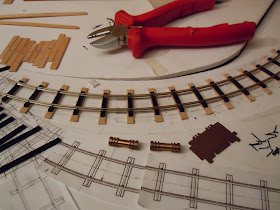First here's an explanation for the limited progress for the last couple of weeks! The view from our Hotel room in Crete. It's rather bright because there was a funny yellow ball in the sky...

Since I've been back I've been concentrating on building the track for the layout - after all it won't be much of a model railway without rails! The track at Thakeham was pre-fabricated industrial track with steel sleepers, essentially 2' gauge train set track. The KB Scale Hudson track sleepers are ideal for this, albeit with a different profile but good enough for me. However looking at the photos it seems the track was laid on top of wooden sleepers, so I am using wooden coffee stirrers underneath the plastic "steel" sleepers.

The approach is then to spike the rails (Peco IL-115 code 82 flat-bottom) to the sleepers using KB scale spikes. Although the sleepers have the holes pre-drilled, the coffee stirrers don't, so a drill in a pin vice was used, tedious but easy enough so far. Then I discovered the spikes didn't fit! The head is too deep, meaning it didn't clear the head of the rail, and if it did it pushes into the web moving the rail out of gauge, and making the second spike impossible to fit. They fitted if turned about 80 degrees, but then they did't grip the rail well either... After some experimentation the answer was the big pair of side cutters seen above!

This close-up shows an unmodified track spike (left) with one that has had the head cut down (right), only about 1mm needs removing but it has made fitting them much easier, and the track stays in gauge. Also visible are the pencil marks used to locate the plastic sleepers as the wooden sleepers obscure the printed template. With plain track now sorted, and I have to say looking quite good from this close, it is time to move on to the points!





